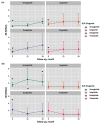Beyond Glycemic Control: GLP-1 Receptor Agonists and Their Impact on Calcium Homeostasis in Real-World Patients
- PMID: 39201039
- PMCID: PMC11355112
- DOI: 10.3390/jcm13164896
Beyond Glycemic Control: GLP-1 Receptor Agonists and Their Impact on Calcium Homeostasis in Real-World Patients
Abstract
Background/Objectives: The effect of glucagon-like peptide-1 receptor (GLP-1R) agonists on calcium homeostasis is poorly understood. This study aimed to investigate the association between GLP-1R agonist use and the risk of hypocalcemia and/or hypercalcemia, as well as other clinical outcomes. Methods: A retrospective cohort study used de-identified patient data from the TriNetX Global Collaborative Network, including 15,655 adult patients prescribed GLP-1R agonists and 15,655 propensity-matched controls. Outcomes included hypocalcemia, hypercalcemia, emergency visits, hospitalizations, cardiovascular events, and all-cause mortality. Results: GLP-1R agonist use was associated with a reduced risk of hypocalcemia (2.7% vs. 5.5%, RR 0.49, 95% CI: 0.44-0.55) but an increased risk of hypercalcemia (2.3% vs. 1.1%, RR 2.02, 95% CI: 1.69-2.42). The effect on hypocalcemia was most pronounced during the first six months of treatment. Among individual agents, tirzepatide showed the most pronounced effect, reducing hypocalcemia risk by 63% while increasing hypercalcemia risk by 85%. Semaglutide demonstrated similar effects, while dulaglutide and liraglutide showed modest effects. Furthermore, GLP-1R agonist use was associated with reduced risks of emergency visits (RR 0.57, 95% CI: 0.54-0.60), hospitalizations (RR 0.40, 95% CI: 0.36-0.44), cardiovascular events, and all-cause mortality (HR 0.27, 95% CI: 0.21-0.36). Conclusions: GLP-1R agonists exhibit a complex influence on calcium homeostasis, reducing hypocalcemia risk while increasing hypercalcemia risk. Beyond calcium regulation, these medications significantly reduce healthcare utilization, improve cardiovascular outcomes, and decrease mortality. Further research is needed to elucidate the mechanisms behind the differential effects of individual GLP-1R agonists, particularly tirzepatide, to optimize personalized treatment approaches and long-term safety.
Keywords: GLP-1R agonists; all-cause mortality; calcium homeostasis; cardiovascular events; healthcare utilization; long-term safety; obesity; personalized treatment; propensity-matched controls; type 2 diabetes.
Conflict of interest statement
The authors declare no conflicts of interest.
Figures

Similar articles
-
Cardiovascular Actions and Clinical Outcomes With Glucagon-Like Peptide-1 Receptor Agonists and Dipeptidyl Peptidase-4 Inhibitors.Circulation. 2017 Aug 29;136(9):849-870. doi: 10.1161/CIRCULATIONAHA.117.028136. Circulation. 2017. PMID: 28847797 Review.
-
The value of short- and long-acting glucagon-like peptide-1 agonists in the management of type 2 diabetes mellitus: experience with exenatide.Curr Med Res Opin. 2016;32(1):61-76. doi: 10.1185/03007995.2015.1103214. Epub 2015 Nov 11. Curr Med Res Opin. 2016. PMID: 26439329 Review.
-
Asthma Exacerbations in Patients with Type 2 Diabetes and Asthma on Glucagon-like Peptide-1 Receptor Agonists.Am J Respir Crit Care Med. 2021 Apr 1;203(7):831-840. doi: 10.1164/rccm.202004-0993OC. Am J Respir Crit Care Med. 2021. PMID: 33052715 Free PMC article.
-
Neuroprotective effects of GLP-1 receptor agonists in neurodegenerative Disorders: A Large-Scale Propensity-Matched cohort study.Int Immunopharmacol. 2024 Dec 25;143(Pt 3):113537. doi: 10.1016/j.intimp.2024.113537. Epub 2024 Oct 31. Int Immunopharmacol. 2024. PMID: 39486172
-
GLP-1 receptor agonists in the treatment of type 2 diabetes - state-of-the-art.Mol Metab. 2021 Apr;46:101102. doi: 10.1016/j.molmet.2020.101102. Epub 2020 Oct 14. Mol Metab. 2021. PMID: 33068776 Free PMC article. Review.
References
-
- Paradiz Leitgeb E., Kercmar J., Krizancic Bombek L., Pohorec V., Skelin Klemen M., Slak Rupnik M., Gosak M., Dolensek J., Stozer A. Exendin-4 affects calcium signalling predominantly during activation and activity of beta cell networks in acute mouse pancreas tissue slices. Front. Endocrinol. 2023;14:1315520. doi: 10.3389/fendo.2023.1315520. - DOI - PMC - PubMed
LinkOut - more resources
Full Text Sources

